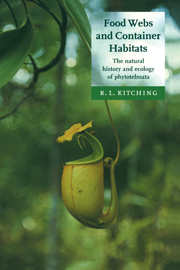Part II - Methods and theories
Published online by Cambridge University Press: 26 August 2009
Summary
I had sieved the tree-hole samples collected that morning from a set of holes perched in the buttress roots of trees deep in the forests near Baiteta in Madang Province of Papua New Guinea. Now in the cool (and, more important, mosquito-free zone) of the laboratory of the Christensen Research Institute I was sorting the detritus under the microscope, counting each of the organisms I encountered. I had carried out the same procedures in Australia, America and Europe and felt the fauna could hold no surprises. I pipetted out a series of mosquito larvae – the heavyweight wrigglers of species of Tripteroides, the even larger predatory monsters that turn into Toxorhynchites. These joined my counts of the larvae of scirtid beetles, midges and so forth. And then, out of left field, into my view swam a paddleworm! This was a surprise: paddleworms, polychaetes, are marine animals which I associated with the rich rockpools of Robin Hood's Bay in North Yorkshire, or the rock shelf at Arrawarra, New South Wales, two of the formative places of my earlier biological education. But not so: it turns out there is just one small subfamily of freshwater polychaetes previously known from the water in tropical leaf axils – and now from water-filled tree holes. It was then perhaps less of a surprise, but no less satisfying, when in a similar circumstance while I was examining samples from water-filled tree holes collected in the lowland rainforests of the Daintree in North Queensland, a flatworm glided across the field of view of yet another sorting tray: a different class of annelid appearing to progress with no visible means of locomotion.
- Type
- Chapter
- Information
- Food Webs and Container HabitatsThe Natural History and Ecology of Phytotelmata, pp. 91 - 92Publisher: Cambridge University PressPrint publication year: 2000



